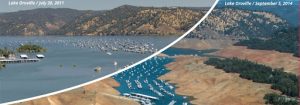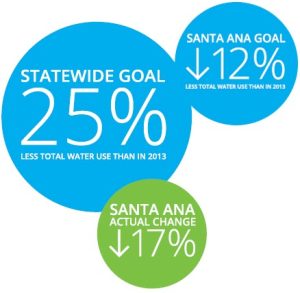Drought 2015
 Throughout California's history there have been periods of low rainfall and even drought. However, the 2015 drought was referred to at the time as the worst in our state's history. The severity of the five-year drought put us in a state of emergency and Governor Brown asked for a voluntary 20% reduction in water use statewide.
Throughout California's history there have been periods of low rainfall and even drought. However, the 2015 drought was referred to at the time as the worst in our state's history. The severity of the five-year drought put us in a state of emergency and Governor Brown asked for a voluntary 20% reduction in water use statewide.
That same year, the City of Santa Ana adopted a strategic plan, which—among other important initiatives— focused on completing the City's Climate Action Plan with measures to address water conservation, energy efficient buildings (city and community) and greenhouse gas emissions. Creating awareness for and educating the community about water conservation is an important component of the plan.
Here is a timeline of the 2015 drought and the measures taken by the City of Santa Ana.
2015
Drought conditions looked even more dire in 2015. The close of our official rainy season, which provides California with 90% of its water, was marked with record high temperatures and record low rainfall. Reservoirs were low. Landscapes were parched. And the Sierra Nevada snowpack, which usually supplies 30% of the state's water as it melts through early summer, was at its second-lowest level on record.
It was no surprise, then, that Governor Brown issued an Executive Order on April 1, 2015 that called for the first-ever statewide mandatory water reduction to slash water use by 25% (compared to 2013 levels) and increase enforcement to prevent wasteful water use. As a result, the State Water Resources Control Board (SWRCB) adopted an expanded emergency regulation and has imposed a new round of water conservation rules, including sharp restrictions on landscape watering as well as orders to restaurants not to serve water to customers unless asked.
Since Santa Ana had already reduced its water consumption by 13% since 2013, the City called for a mandatory 12% reduction in water use and issued emergency conservation requirements for all water users to comply with state regulations and local ordinances.
Santa Ana's drought campaign
Santa Ana's Water Resources Division launched a comprehensive campaign called "Every Drop Counts: Let's Not Waste It" in 2015. The campaign was designed to educate the community about the drought, Santa Ana's Level 2 Water Shortage requirements, and ways to conserve water and help the City reach its 12% target.
Under this campaign, we used every possible channel for our outreach. We sent out bill inserts and newsletter articles. We posted online articles and pushed out water saving tips through social media. We created pull-up banners and flyers for public areas and events. We displayed outdoor ads at bus shelters and used LED billboards at Santa Ana College and Santa Ana Stadium to reinforce our conservation message. We also lined main thoroughfares with banners, each featuring an important water saving tip. We even wrapped our community outreach vehicle with the "Every Drop Counts" logo and designed special campaign t-shirts and yard signs to pass out to residents at community events.
In The Community: We attended more than 100 events in 2105. From weekly farmer's markets and neighborhood association meetings to SOMOS and the Plaza Wellness 5K Run, our staff was on hand to pass out Santa Ana's award winning water, free giveaways as well as conservation flyers and other promotional items.
Education: Recognizing the importance of educating kids about conservation, we launched an annual Youth Poster Contest using our campaign theme to teach wise water use. We promoted it through the Santa Ana Unified School District, recreation centers and several special events at Bowers Museum, The Discovery Cube OC and MainPlace. Read more about the contest here.
2016
Dry conditions in California eased in 2016. The snowpack in the Sierra Nevada was greater than it had been in years, peaking at 87% in March. Even the storms that soaked Northern California earlier this year helped ease conditions by giving some of California's largest and most important reservoirs a boost.
At the same time, Californians narrowly missed meeting the 25% water-saving target set by Governor Brown in 2015. Reducing consumption by 23.9%, the conservation efforts in California saved about 368 billion gallons of water, or enough to supply nearly 6 million people for a year.
 How did Santa Ana's conservation efforts rate?
How did Santa Ana's conservation efforts rate?
"Every Drop Counts" made a difference and residents took the conservation message to heart. We exceeded our target. In fact, as a community, we cut our water use by 17%.
The City of Santa Ana rated below the state average in residential gallons per capita. And, with the exception of City of Fountain Valley, Santa Ana came in lower than all other water districts nearby.
Santa Ana has done an excellent job reducing its water consumption and we are confident that, as a community, we will continue to conserve this precious resource.
2017
Governor Jerry Brown declared an end to California’s historic five-year drought in April. The record rain has helped build up our reservoirs, and the snowpack across the Sierra Nevada was between 150% and 175% above normal. These conditions brought relief to most of California, taking us out of a state of emergency. However, there are long term impacts from the drought that will require more than one wet season to resolve. Reducing water use remains as important as ever as we work to replenish our depleted groundwater supply and prepare for likely future droughts.
For this reason, while the City of Santa Ana eased restrictions, residents are encouraged to continue conserving. Remaining in place are the City's Permanent Water Conservation Restrictions, which prohibit wasteful practices.
